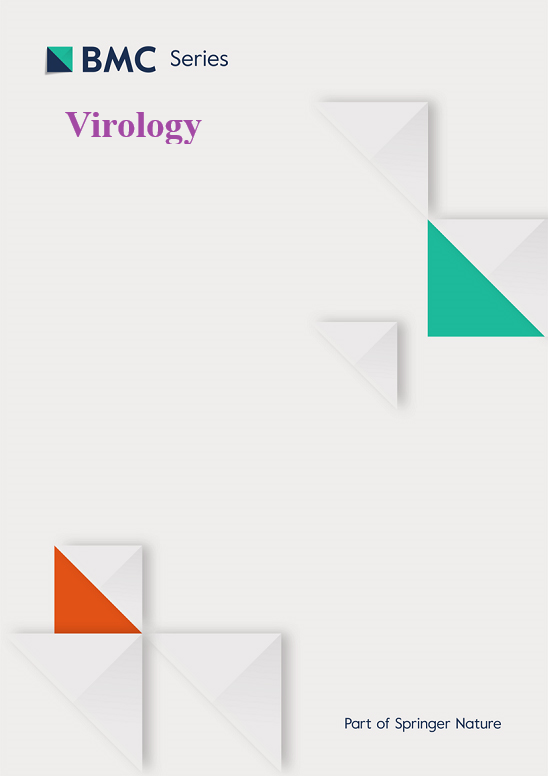Construction of watermelon mosaic virus-Beijing isolate infectious clone and study of the dynamic localization and accumulation of virus-encoded proteins
IF 2.8
3区 医学
Q3 VIROLOGY
引用次数: 0
Abstract
Potyvirus is the largest genus of plant RNA viruses, and the members in the genus are known to cause significant damage to a wide variety of crops. In this study, we performed small RNA (sRNA) deep sequencing for identification of potential virus (es) in collected cucumber leaves with mosaic symptoms from fields in Beijing. Through this high-throughput sequencing and subsequent PCR amplification, we obtained a complete viral genome sequence of 10,044 bp, which showed the highest similarity to the watermelon mosaic virus (WMV) isolate FBR04-37 and exhibited the typical characteristics of potyviruses in its genome organization. The obtained WMV isolate was designated as WMV-BJ. We then constructed the infectious clone of WMV-BJ, which can successfully infect six kinds of cucurbitaceous plants by agroinfiltration. Among these, Cucumis melo showed obvious symptoms such as shrinkage and mosaic compared to other cucurbitaceous plants infected by this virus infectious clone. To understand the biological function of WMV-BJ, we further analyzed the dynamic subcellular localization and protein accumulation of WMV-BJ encoded 11 viral proteins. The results showed the WMV-BJ-encoded proteins displayed diverse subcellular localizations, and most viral proteins were easily degraded after expression in plant cells. Together, the construction of the WMV-BJ infectious clone in this study provides a valuable tool for further exploring the biology of this virus and the interaction between WMV-BJ and host plant, and useful information for investigating the functions of WMV-encoded proteins.
西瓜花叶病毒北京分离株感染克隆的构建及病毒编码蛋白的动态定位和积累研究
Potyvirus是最大的植物RNA病毒属,已知该属的成员对多种作物造成重大损害。在本研究中,我们利用小RNA (sRNA)深度测序技术对北京地区黄瓜叶片进行了潜在病毒的鉴定。通过高通量测序和随后的PCR扩增,我们获得了10044 bp的完整病毒基因组序列,该序列与西瓜花叶病毒(WMV)分离物FBR04-37的相似性最高,在基因组组织上表现出典型的多型病毒特征。得到的WMV分离物命名为WMV- bj。构建了WMV-BJ的侵染无性系,该无性系可通过农业渗透侵染6种葫芦科植物。其中,与感染该病毒的其他葫芦科植物相比,甜瓜表现出明显的收缩和花叶等症状。为了了解WMV-BJ的生物学功能,我们进一步分析了WMV-BJ编码的11种病毒蛋白的动态亚细胞定位和蛋白质积累。结果表明,wmv - bj编码的蛋白具有不同的亚细胞定位,大多数病毒蛋白在植物细胞中表达后容易降解。总之,本研究构建的WMV-BJ侵染克隆为进一步研究该病毒的生物学特性及与寄主植物的相互作用提供了有价值的工具,也为研究wmv编码蛋白的功能提供了有用的信息。
本文章由计算机程序翻译,如有差异,请以英文原文为准。
求助全文
约1分钟内获得全文
求助全文
来源期刊

Virology
医学-病毒学
CiteScore
6.00
自引率
0.00%
发文量
157
审稿时长
50 days
期刊介绍:
Launched in 1955, Virology is a broad and inclusive journal that welcomes submissions on all aspects of virology including plant, animal, microbial and human viruses. The journal publishes basic research as well as pre-clinical and clinical studies of vaccines, anti-viral drugs and their development, anti-viral therapies, and computational studies of virus infections. Any submission that is of broad interest to the community of virologists/vaccinologists and reporting scientifically accurate and valuable research will be considered for publication, including negative findings and multidisciplinary work.Virology is open to reviews, research manuscripts, short communication, registered reports as well as follow-up manuscripts.
 求助内容:
求助内容: 应助结果提醒方式:
应助结果提醒方式:


